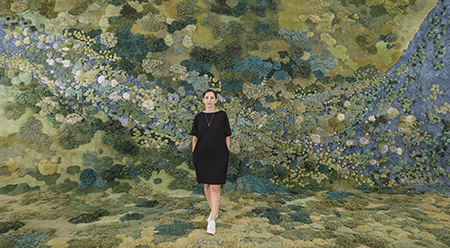 An unprecedented and large-scale global exhibition of art, design and architecture will be showcased in the inaugural NGV Triennial opening on 15 December 2017.
An unprecedented and large-scale global exhibition of art, design and architecture will be showcased in the inaugural NGV Triennial opening on 15 December 2017.
The National Gallery of Victoria (NGV) has today, announced the artists and designers included in the NGV Triennial, traversing established, mid-career and emerging practitioners at the forefront of their fields. Featuring more than 60 artists from over 30 countries and free and exclusive to Melbourne, the NGV Triennial will include major presentations from international and Australian artists across all four levels of NGV International.
Selected for their diversity and dynamism of practice, the inaugural NGV Triennial artists and designers are embracing cutting edge technologies, from 3D printing to robotics, as well as performance, film, painting, drawing, fashion design, tapestry and sculpture. In particular, the exhibition will showcase work from regions not strongly represented in the NGV’s current holdings including Africa, South America and the Middle East.
Occurring every three years and supported by the Victorian Government through the Creative State strategy, the NGV Triennial is an ongoing exhibition series and considered one of the most ambitious projects in the NGV’s history. Adopting an interdisciplinary approach to the display of art and design, the Triennial will explore the social, cultural, scientific and physiological terrains of our contemporary world.
“We believe that the ambition, depth and diversity of the artists and designers in the inaugural NGV Triennial will ensure our audience has a truly unforgettable cultural experience,” said Tony Ellwood, Director NGV. “Through the building of the NGV’s collection of contemporary art and design, we hope the NGV Triennial will become a critical and ongoing asset for Victoria.”
During the process of seeking out a group of the best artists and designers from across the globe, five conceptual themes have been identified to frame various dialogues throughout the exhibition and associated programs – body, change, movement, time and virtual.
The NGV Triennial has enabled large-scale new commissions and acquisitions, to create a fundamental legacy for both the NGV Collection and wider community. These major commissions include architecture, design, sculpture, installation, moving image and interactive works exploring new media and technology. Twenty major new works have been commissioned by the NGV for the NGV Triennial including:
- Alexandra Kehayoglou (Argentina) – using her family’s traditional carpet-making techniques, a monumental 100m2 carpet landscape titled Santa Cruz River that documents one of Argentina’s most contested landscapes;
- Candice Breitz (South Africa) – a new video work that reveals the personal histories of six refugees, which sees Hollywood actors Julianne Moore and Alec Baldwin give voice to their stories to bring the privilege of celebrity into contrast with the hardship of the refugee experience;
- Estudio Campana (Brazil), Yarrenyty Arltere Artists (Australia) and Elliat Rich (France) – an important collaboration that draws upon the shared cultural motifs of the artists to create a brightly coloured upholstered dome, to be used as a meeting point and welcoming entrance to the exhibition;
- Formafantasma (Italy) – a new body of research by the Italian designers that investigates the impact of the global trade in rare earth materials for consumer goods such as smartphones;
- Guo Pei (China) – an installation of elaborate, Marie Antoinette-inspired gowns from Pei’s latest haute couture collection Legend, following the designer’s work being catapulted onto the international stage when Rihanna wore her canary-yellow ball gown and cape to the 2015 Met Ball;
- PET Lamp (Spain) and Bula’bula Artists (Australia) – a cross-cultural collaboration between Spanish-based designers PET Lamp and Indigenous women weavers from the Northern Territory to produce the first Australian version of a PET Lamp, a project that emerged in response to the global issue of plastic waste;
- Richard Mosse (Ireland) – a three-channel video that uses a high-tech long-range military camera to capture events surrounding the crisis in Syria and subsequent flood of refugees, jointly commissioned by the NGV and London’s Barbican Art Gallery;
- Ron Mueck (Australia) – an epic sculptural display from the Melbourne-born, UK-based artist that will intervene with works in the NGV’s 18th century gallery spaces, in Mueck’s largest and most extraordinary work to date;
- Sissel Tolaas (Norway) – the renowned ‘smell designer’, with a personal library of 7,000 smells and 2,500 molecules, will create a ‘scent of Melbourne’ for the NGV Triennial;
- teamLab (Japan) – an interactive and immersive installation from the famous ‘ultratechnologist’ design collective that digitally recreates a ‘vortex’ that responds as water would to the audience’s presence and movement;
- Xu Zhen (China) – a dramatic and immense sculptural installation that features replicas of famous classical sculptures adorning a 15.8m long sculpture of Buddha, considering the role of tradition and ritual in our increasingly global world;
- Yayoi Kusama (Japan) – one of the most respected senior artists working today, Kusama will present a major new participatory project in which visitors will ‘obliterate’ a specially made domestic setting with flower motifs, referencing her first experience of hallucination, and;
- 2017 NGV Architecture Commission – a national architectural competition to design a temporary, site-specific work of architecture for the Grollo Equiset Garden at NGV International.
The inaugural NGV Triennial opens on 15 December 2017, and runs to 15 April 2018. For more information, and complete list of participating artists, visit: www.ngv.vic.gov.au for details.
Image: Alexandra Kehayoglou with her work No Longer Creek (2016) – at the artist announcement for the 2017 NGV Triennial – photo by Wayne Taylor
